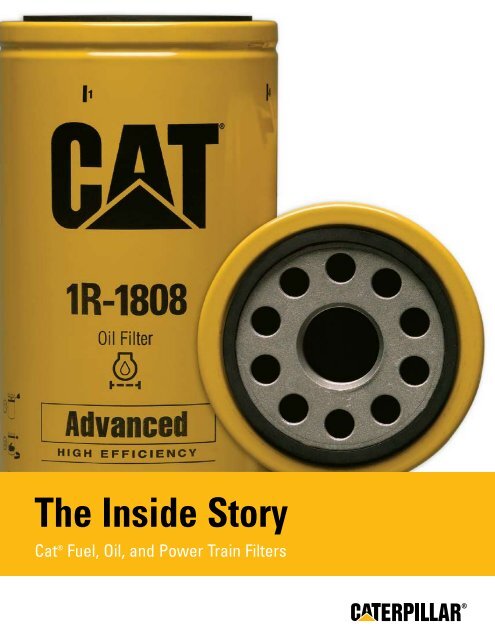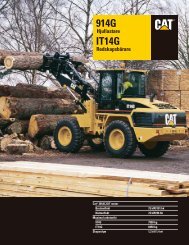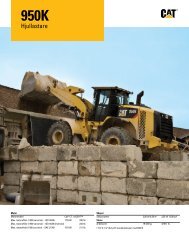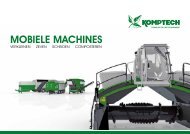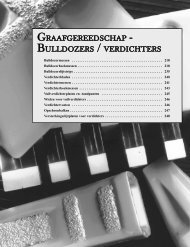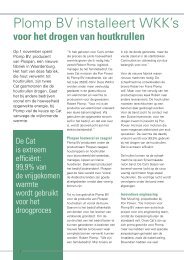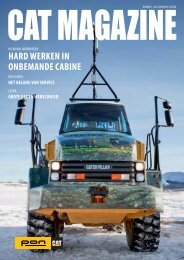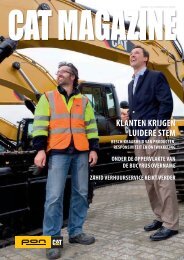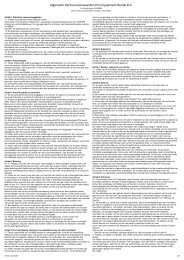The Inside Story - Pon / Cat
The Inside Story - Pon / Cat
The Inside Story - Pon / Cat
You also want an ePaper? Increase the reach of your titles
YUMPU automatically turns print PDFs into web optimized ePapers that Google loves.
<strong>The</strong> <strong>Inside</strong> <strong>Story</strong><br />
<strong>Cat</strong> ® Fuel, Oil, and Power Train Filters
Visibly Better<br />
C a t ® F u e l , O i l , a n d<br />
P o w e r T r a i n F i l t e r s<br />
<strong>Cat</strong> ® Filters are simply made better.<br />
See for yourself. With <strong>Cat</strong> Filters, the differences are visible. <strong>Cat</strong><br />
Filters are manufactured to meet the most demanding engineering<br />
specs for filters—those specified by <strong>Cat</strong>erpillar. Our goal—to see<br />
that <strong>Cat</strong> Engine, fuel and power train component systems are<br />
protected as well on the day before an oil change as they are the<br />
day after.<br />
<strong>Cat</strong> Filters offer quality features that other filters don't.<br />
• Acrylic beads to prevent pleat bunching.<br />
• Spiral roving for greater pleat stability.<br />
• A nylon center tube and aluminum base plate to prevent metal<br />
contamination.<br />
• Molded end caps to prevent leaks.<br />
Another quality feature is the heavy gauge can that protects every<br />
<strong>Cat</strong> Filter. <strong>The</strong> one-piece design means greater burst pressures, better<br />
performance during cold starts and leaks are virtually eliminated.
Only <strong>Cat</strong> ® Filters have acrylic beads to<br />
prevent pleat bunching, a common problem<br />
experienced by virtually all other filters.<br />
When pleats bunch, the available filter area<br />
drops significantly. As a result, a filter can go<br />
into bypass and allow contaminants into your<br />
engine or other component systems. Thus<br />
other brands of filters may need to be<br />
replaced before reaching recommended<br />
change intervals.<br />
But with <strong>Cat</strong> Filters you can see the<br />
difference. Because of acrylic beads,<br />
<strong>Cat</strong> Filters pleat spacing is rigidly maintained<br />
to maximize the surface area throughout the<br />
life of the filter. Maximum surface area<br />
means maximum filter dirt-holding capacity.<br />
<strong>Cat</strong> Filters can be relied upon for the entire<br />
recommended change period without<br />
jeopardizing component life. This can<br />
mean fewer oil changes per year,<br />
decreased downtime and<br />
overall operating costs.<br />
Pleat spacing on <strong>Cat</strong> Filters is rigidly maintained by acrylic beads<br />
to provide maximum filter surface for better engine<br />
and component system protection and longer life than<br />
other filters.<br />
Acrylic Beads<br />
C a t ® F u e l , O i l , a n d P o w e r T r a i n F i l t e r s
Spiral Roving<br />
C a t ® F u e l , O i l , a n d P o w e r T r a i n F i l t e r s<br />
<strong>Cat</strong> ® Filters feature a unique fiberglass spiral roving to insure<br />
that pleats don't flex, putting an end to pleat movement.<br />
With other brands of filters, pleats are able to move<br />
or “flex.” This can release contaminants into the oil,<br />
fuel, or hydraulic fluid and cause premature wear.<br />
<strong>Cat</strong> Filters trap and hold contaminants.<br />
<strong>The</strong> spiral roving on <strong>Cat</strong> Filters means more effective filtration.<br />
With no “pleat movement” contaminants stay locked in the filter<br />
and out of your engine, drive train, and hydraulic systems.<br />
Every day a machine or engine is started, cold fluid flows<br />
into the filters. Without the pleat stability provided<br />
by spiral roving, many previously trapped<br />
contaminants break loose. <strong>The</strong>se particles<br />
re-enter the system, causing additional<br />
wear, and must be captured again.<br />
Fiberglass spiral roving of <strong>Cat</strong> ® Filters keeps pleats stable and in place, allowing for better filtration.<br />
In fuel filters, particles breaking loose are not recaptured and cause abrasive injector wear.<br />
This graph illustrates the benefit of spiral roving.<br />
250<br />
45% Increase in Particles Not Trapped<br />
Particles<br />
200<br />
150<br />
100<br />
50<br />
0<br />
123<br />
<strong>Cat</strong> Filter with Spiral<br />
Roving & Beads<br />
45%<br />
179<br />
<strong>Cat</strong> Filter without<br />
Spiral Roving
Unlike other filters, <strong>Cat</strong> ® Filters have a nylon center tube which<br />
means there is no chance of metal contamination. <strong>The</strong> nonmetallic<br />
center tubes are 30% stronger than metal tubes.<br />
Molded Endcaps<br />
C a t ® F u e l , O i l , a n d P o w e r T r a i n F i l t e r s<br />
Only <strong>Cat</strong> Filters are made with non-metallic<br />
center tubes to better protect your engine<br />
and other component systems.<br />
By inserting filter pleats into the liquid urethane as the end caps are being formed, a<br />
virtually impenetrable bond is formed to protect your system from contaminants.<br />
Conventional filters have metal center tubes,<br />
which can leave metal contaminants from<br />
the manufacturing process inside the filter.<br />
<strong>The</strong>se metal fragments can lead to scored<br />
bearings and cause damage to other critical<br />
system components.<br />
<strong>Cat</strong> Filter center tubes are clearly better<br />
because they use fiberglass-reinforced<br />
nylon instead of metal, so there is no chance<br />
of metal contamination. <strong>The</strong>se center tubes<br />
are cleaner and protect components, instead<br />
of possibly causing damage. Plus, <strong>Cat</strong> nonmetallic<br />
center tubes are 30% stronger than<br />
typical metal tubes to help prevent collapse<br />
during pressure spikes and cold oil start-ups.<br />
<strong>Cat</strong> ® Filters virtually eliminate<br />
contaminants from entering<br />
the engine, drive train and<br />
hydraulic systems with one-piece,<br />
molded polyurethane end caps.<br />
On other filters, end caps<br />
are metal and are glued directly to<br />
the filter pleats. This can cause gaps<br />
between the metal and pleats that<br />
can allow contaminants to leak<br />
between the filter media and the end cap.<br />
Center Tube<br />
C a t ® F u e l , O i l , a n d P o w e r T r a i n F i l t e r s<br />
<strong>Cat</strong> Filters' structural integrity is better<br />
because filter pleats are actually inserted<br />
into the liquid urethane as the end caps are<br />
being formed. As the polyurethane hardens<br />
an impenetrable bond is formed between the<br />
pleats and end caps. <strong>The</strong> possibility of gaps is<br />
eliminated, keeping contaminants in the filter and<br />
out of your system. <strong>Cat</strong> Filters also feature a one-piece,<br />
aluminum base plate to further protect components from<br />
leaks and ferrous metal contamination.
Out of Sight<br />
Contamination Control<br />
I s N o t O u t O f M i n d<br />
C a t ® F u e l , O i l , a n d P o w e r T r a i n F i l t e r s<br />
Sources of Fuel Contamination<br />
In the fuel<br />
A reliable fuel supplier is your best<br />
defense against source contamination.<br />
Demand periodic sampling and testing<br />
to ensure the consistent quality you<br />
need for top performance.<br />
Dirty fuel is your engine's worst enemy. Silently, quietly, this unseen<br />
villain can rob your engine of power, accelerate wear of sensitive<br />
fuel system components and reduce fuel efficiency. Keeping your<br />
fuel and fuel system clean should be a top priority. With the higher<br />
injection pressures and closer tolerances of today's diesel engines,<br />
clean fuel delivers maximum performance, fuel efficiency,<br />
productivity, and service life.<br />
During operation<br />
In dusty environments, airborne<br />
contaminants can be drawn into<br />
your fuel tank through the vent tube.<br />
Likewise, a vent in the fuel tank cap<br />
can ingest dust if it is not properly<br />
sealed. Contaminants can also develop<br />
during storage, or they can enter the<br />
system through improper fuel transfer.<br />
During Service<br />
Any time your fuel system is open,<br />
whether it is to change filters, make<br />
repairs or for refueling, contaminants<br />
can enter the system.<br />
Advanced efficiency means more protection<br />
<strong>Cat</strong> ® Advanced Efficiency Fuel Filters are specially designed for<br />
today's higher injector pressures and precision components,<br />
using a super-fine filtration media to remove more than 98 percent<br />
of particles 4 microns and larger. By comparison, standard <strong>Cat</strong> Fuel<br />
Filters have a minimum particle size of 15 microns. Advanced<br />
Efficiency Fuel Filters result in maximum performance, longer<br />
component life, fewer repairs and lower engine operating costs.<br />
<strong>The</strong> most measurable and controllable contaminants are<br />
particulates. <strong>The</strong>y can vary greatly in size, hardness and abrasion.<br />
<strong>The</strong> comparison illustrated below demonstrates the very tight<br />
clearances in your fuel system and the size of particles.<br />
As you can see, even particles that you can't see<br />
(smaller than 80 microns) can wear away at your<br />
fuel injectors and reduce performance.<br />
One critical element in any fuel<br />
contamination control program<br />
is <strong>Cat</strong> ® Advanced Efficiency Fuel<br />
Filters. <strong>The</strong>y're specially designed<br />
for today's diesels, using a<br />
super-fine cellulose/synthetic<br />
blend media for maximum filtration.<br />
Fuel system components are more<br />
sensitive than ever to fuel contaminants,<br />
but you can maintain performance and<br />
extend component life by carefully<br />
managing your fuel-related<br />
operations and procedures.<br />
Human Hair Standard Filtration Damages Fuel Systems Advanced Efficiency Filtration<br />
(80 microns) (15 microns) (5-10 microns) (4 microns)
Not all filters are equal. While other filters may be lower priced,<br />
it's important to know they provide significantly less protection.<br />
And with today's sophisticated engine and other component<br />
systems, that's a risk that just doesn't make sense to take.<br />
Only <strong>Cat</strong> ® Filters have these quality design features:<br />
• One-piece molded end caps prevent leaks<br />
• Acrylic beads prevent pleat bunching<br />
• Spiral roving keeps pleats from “moving”<br />
• Nonmetallic center tubes to protect your engine<br />
Because <strong>Cat</strong> Filters are made better, they provide consistent<br />
performance to protect your engine, drive train, and hydraulic<br />
systems. While other filter brands may fit, <strong>Cat</strong> Filters offer the<br />
superior quality and protection you need to maximize your<br />
engine and other component system’s life.<br />
Get the <strong>Inside</strong> <strong>Story</strong>.<br />
LEDQ6225-04<br />
www.cat.com<br />
© 2008 <strong>Cat</strong>erpillar | All Rights Reserved | Printed in USA<br />
CAT, CATERPILLAR, their respective logos, “<strong>Cat</strong>erpillar Yellow” and the POWER EDGE trade dress, as well as<br />
corporate and product identity used herein, are trademarks of <strong>Cat</strong>erpillar and may not be used without permission.


